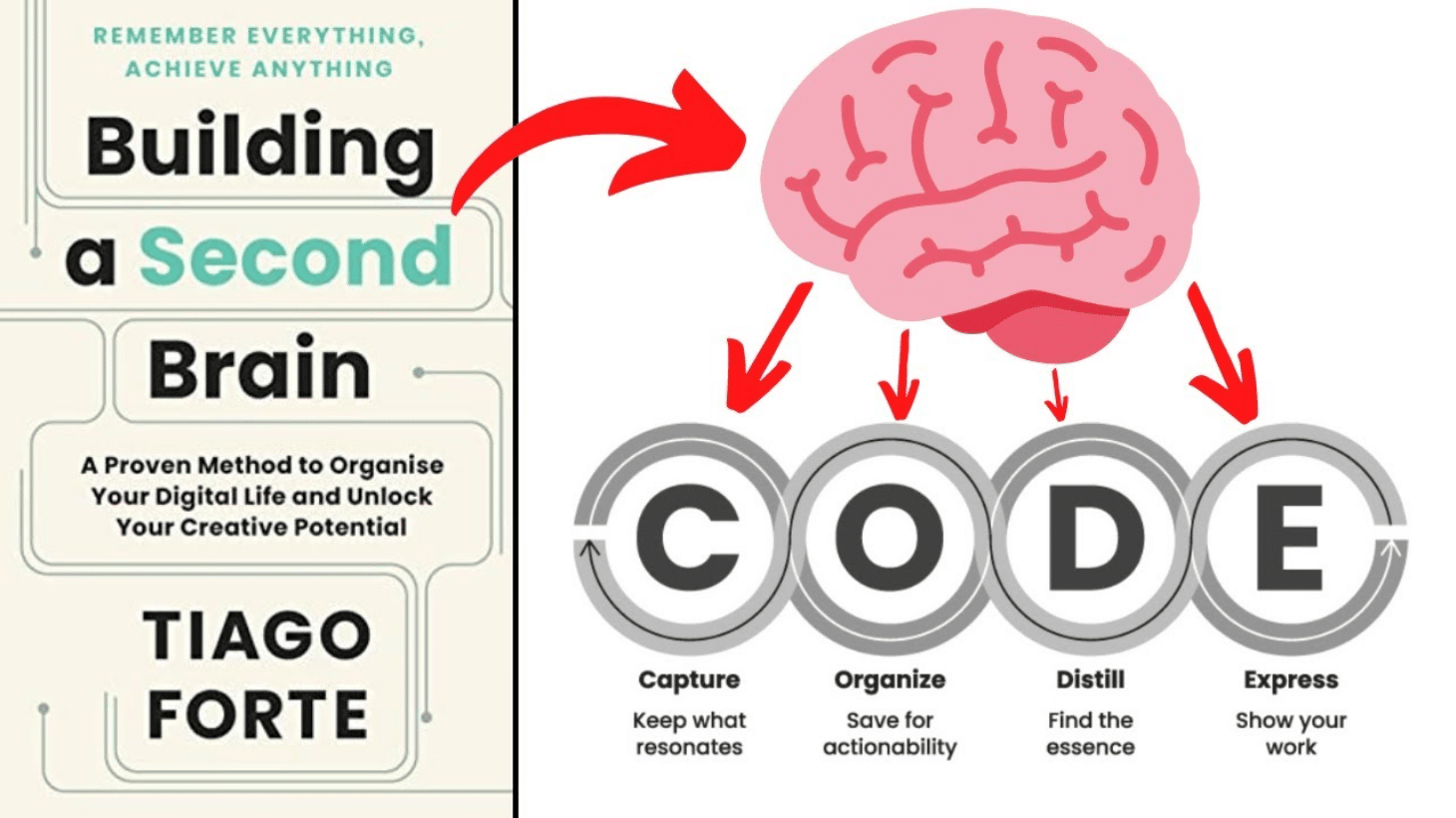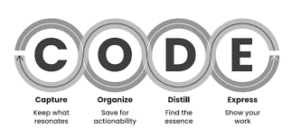
Building a Second Brain
UP: Books Podcast Episode: The Growth Guide with Tiago Forte
📚The Book in 3 Sentences
- A Second Brain is a Personal Knowledge Management System (PKM), which helps you:Make ideas concrete
- Incubate ideas over time
- Sharpen our unique perspective
- Reveal associations between ideas
- C.O.D.E. Information Capture is the way we capture information – Capture, Organize, Distill, and Express
- We only want to capture information that meets these criteria:
- Is it useful
- Is it personal
- Is it surprising
- Does it inspire me
💗 1. Impressions
I was a big fan of this book.
It’s why you’re reading this right now.
My intention is to turn my website into my 2nd Brain, which you can use alongside me.
I’ll be sharing book reviews, conversations with authors, and what I learn on my journey of growth.
🧭 How I Discovered It
I found Tiago Forte on Twitter and enjoyed his work and reached out to him to have a conversation on the Podcast.
👤 Who Should Read It?
If you want to better organize your life, work or research, this book is for you.
🦋 How the Book Changed Me
- I focus more on my notes
- I’m implementing systems to track my life
- I have a goal to turn my website into my second brain.
✍️ My Top 3 Quotes
- It is when you begin expressing your ideas and turning your knowledge into action that life really begins to change.
- Like a scientist capturing only the rarest butterflies to take back to the lab, our goal should be to “capture” only the ideas and insights we think are truly noteworthy
- The purpose of knowledge is to be shared. What’s the point of knowing something if it doesn’t positively impact anyone, not even yourself?
📒 2. Summary + Notes
PKM = Personal Knowledge Management
4 Superpowers of a Second Brain are:
- Make ideas concrete
- Incubate ideas over time
- Sharpen our unique perspective
- Reveal associations between ideas
Make ideas concrete
When we declutter our brain, we make room to create and effectively act on our ideas
Incubate ideas over time
When we capture our ideas and leave them accessible, it allows us to have a slow burn of creativity over time as the ideas percolate in the background.
Sharpen our unique perspective
It isn’t about the information, it’s about the interpretation of information.
We need to learn how to promote or defend a particular perspective.
Reveal associations between ideas
Creativity is about connecting ideas together, especially those that seem not to be connected.
When we keep diverse notes together, we can start to make connections we wouldn’t have anticipated.
**PKM = Personal Knowledge Management**
*4 Superpowers of a Second Brain are:*
Make ideas concrete
Incubate ideas over time
Sharpen our unique perspective
Reveal associations between ideas
**Make ideas concrete**
When we declutter our brain, we make room to create and effectively act on our ideas
**Incubate ideas over time**
When we capture our ideas and leave them accessible, it allows us to have a slow burn of creativity over time as the ideas percolate in the background.
**Sharpen our unique perspective**
It isn’t about the information, it’s about the interpretation of information.
We need to learn how to promote or defend a particular perspective.
**Reveal associations between ideas**
Creativity is about connecting ideas together, especially those that seem to not be connected.
When we keep diverse notes together, we can start to make connections we wouldn’t have anticipated.

CODE Information Capture is the Way we capture information.
Capture – Keep What Resonates
Mine what you’re already reading and listening to.
Capture Criteria
- Is it useful
- Is it personal
- Is it surprising
- Does it inspire me
If you save ideas that contradict each other and don’t support what you believe, you can train yourself to take in information from different sources. When you play with ideas, bending, stretching and remixing them, you become less attached to how they were originally presented and can borrow certain aspects or elements to use in your work.
Generation Effect – you’re more likely to remember information when you write it in your own words
Organize – Save for Actionability
Cathedral Effect – studies show the environment we find ourselves in shapes our thinking -➝ Design a space for your ideas
Notetakers get stuck because they don’t organize for action.
Use the PARA system to organize your information:
Projects – short-term efforts in your work or life you’re working on right now
Areas – Long-term responsibilities you want to manage over time
Resources – Topics or interests that may be useful in the future
Archives – Inactive items from the other three categories
Separate the capture and organization of ideas.
Capture the ideas on a daily basis and organize them in a weekly review.
Distill – Find the Evidence
Break down scenes according to five criteria:
Synopsis
Historical concept
Imagery for the look and feel
Core intention and anything to avoid
Distill the essence of each scene into a sentence, expressing in a few words what the point of the scene was.
Discoverability – the missing link in making notes useful
To survive into the future, notes must be discoverable
The more notes you gather, the less discoverable your notes are
The progressive summarization technique
- Capture notes
- Bold the key ideas
- Highlight the essence of the key ideas
- Summarize the highlights of the key ideas
Express – Show Your Work
The Octavia 3 Rules
- Don’t leave home without a notebook and something to write with
- Ensure your eyes and ears are focused and open – be present
- Don’t use excuses re: what you don’t have – find a way
Put your work into the world early, frequently and in small manageable chunks – the feedback will route into your Second Brain and iterate
Intermediate Packets
Intermediate packets are the concrete, individual building blocks that make up our work and they can be repackaged regularly in our writing, content and teachings.
5 Kinds of intermediate Packets are:
- Distilled notes – books or articles you’ve read
- Outtakes – material or ideas from past projects
- Work-in-process – documents, graphics, etc for current projects
- Final deliverables – concrete pieces of work you’ve delivered for past projects
- Documents created by others – Knowledge assets created by people on your team or consultants you can reference
Working with Intermediate Packets means:
- You’ll become interruption-proof because you’re focusing on small tasks
- You’ll be able to make progress in short periods of time
- Work quality improves with more quality feedback
- You’ll compile multiple IP assets for reuse
Retrieval Methods for your work:
- Tags
- Search
- Browsing
-
Serendipity
Three Stages of Expression:
Create: Complete projects and accomplish goals stress-free
Remember: Retrieve an idea when it’s needed
Connect: Use notes to tell a bigger story
Three Strategies for Creative Work:
Archipelago of Ideas
Divergently gather a group of ideas, sources, or points that will form the backbone of your deliverable.
Once you have a critical mass of ideas, switch to linking them together in an order that makes sense.
Creating your outline digitally offers major advantages:
- The outline is searchable
- More malleable and flexible
- It can be accessed and edited anywhere
- The outline can link to more detailed content
The Hemingway Bridge
Use the last few minutes of each working session to:
- write down ideas for next steps
- Write down the current project status
- Write down any details you have in mind you may forget
- Write out a clear intention you have for your next working session
Dial down the scope
Ship something small and concrete.
People choose to delay difficult projects.
They tell themselves they need more time but that time means delays.
The problem isn’t a lack of time its that we have too large a scope we need to dial down.
The Habits Most Important to your Second Brain:
- Noticing habits
- Project checklists
- Weekly and monthly reviews
These habits are your maintenance schedule
Project kickoff Checklist
Capture current thinking
Review folders or tags for relevant notes
Search for related terms across all your folders
Move or tag relevant notes to the project folder
Create an outline of collected notes and plan the project
Weekly review: Reset to Avoid Overwhelm
- Clear email inbox
- Check your calendar
- Clear your computer desktop
- Clear your notes inbox and categorize
- Choose the tasks you’ll do for the next week
Clear email
Action items get saved to tasks and notes get captured in notes App
Check your calendar
Look at the last few weeks – anything due?
Look at the next few weeks – anything that needs to be acted on?
Clear your computer desktop
Keep the desktop surface (digital and literal) clean
Clear your notes inbox and categorize
Batch process the notes you’ve collected during the week using the PARA system
Choose the tasks you’ll do for the next week
Select tasks you’re going to do next week across all areas of responsibility
Schedule the tasks that you intend to do
✅ 3. Actionable Advice
- Capture information that’s useful, personal, surprising and inspiring.
- Organize the information for actionability
- Express your information to the world
☝️ 4. Potential Weaknesses
I loved the 2nd Brain, but there’s always a challenge.
It can be hard to capture this level of information on a consistent basis.
For people who aren’t wired to capture information and organize their life, this can be a significant change.
🪢 5. Conclusion
I’m going to continue to work on developing my Second Brain and I’ll aim to do it in a way that makes it useful for you, the reader, to follow along.